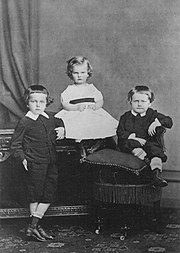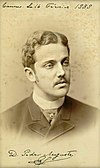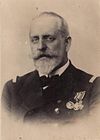| Princess Leopoldina | |||||
|---|---|---|---|---|---|
| Princess of Saxe-Coburg and Gotha Duchess of Saxony | |||||
 Princess Leopoldina around age 17, c.1864 Princess Leopoldina around age 17, c.1864 | |||||
| Born | Princesa Leopoldina do Brasil (1847-07-13)13 July 1847 Paço de São Cristóvão, Rio de Janeiro, Empire of Brazil | ||||
| Died | 7 February 1871(1871-02-07) (aged 23) Palais Coburg, Vienna, Austria-Hungary | ||||
| Burial | St. Augustine's Church, Coburg | ||||
| Spouse |
Prince Ludwig August of Saxe-Coburg and Gotha
(m. 1864) | ||||
| Issue Detail | |||||
| |||||
| House | Braganza | ||||
| Father | Pedro II of Brazil | ||||
| Mother | Teresa Cristina of the Two Sicilies | ||||
| Religion | Catholic Church | ||||
| Signature | |||||
Princess Leopoldina of Brazil (Leopoldina Teresa Francisca Carolina Miguela Gabriela Rafaela Gonzaga; 13 July 1847 – 7 February 1871) was the daughter of Emperor Pedro II and Empress Teresa Cristina. She shared the first name of her grandmother, Empress Maria Leopoldina of Brazil.
A Princess of Brazil from birth, Dona Leopoldina renounced her titles upon her marriage to Prince Ludwig August of Saxe-Coburg and Gotha, taking the title of Princess of Saxe-Coburg and Gotha and Duchess of Saxony.
The princess was also second in the line of succession to the Brazilian throne, even after the marriage of her older sister, Isabel, Princess Imperial of Brazil, due to the latter's difficulties in producing heirs. Her descendants would form the Braganza-Saxe-Coburg and Gotha branch of the Imperial House of Brazil.
Biography
Family and early years
Leopoldina was born at 6:45 am on 13 July 1847, in the Imperial Palace of São Cristóvão, the second daughter of Pedro II and Teresa Cristina of the Two Sicilies. Her paternal grandparents were the Emperor Pedro I and Empress Maria Leopoldina, and her maternal grandparents were King Francis I of the Two Sicilies and Queen Maria Isabella.

She was baptized in the Cathedral and Imperial Chapel on 7 September 1847, by the bishop chief chaplain and diocesan gift Manuel do Monte Rodrigues de Araújo, Count of Irajá, and her name was given in honor of her paternal grandmother. Her godparents were her uncle and aunt, the Prince and Princess of Joinville—for which C. His de Buthenval, the minister plenipotentiary of Louis Philippe I of France, stood proxy—and Mariana Carlota de Verna Magalhães Coutinho, Countess of Belmonte and chief chamberlain of the Empress. From an early age, Pedro II sought to obtain a preceptor for his daughters. The choice fell on the Countess of Barral, indication of the Princess of Joinville, who began her functions in September 1855. Numerous teachers were instructed to educate the two young women, who followed an elaborate and rigorous system of studies constantly monitored by the Emperor.
The princesses attended classes six days a week, from 7 a.m. to 9:30 p.m. They could only receive visits on Sundays, at parties or on any other occasion determined by the Emperor. The subjects they studied were diverse: Portuguese and its Literature, French, English, Italian, German, Latin, Greek, Algebra, Geometry, Chemistry, Physics, Botany, History (whose subjects were divided by country and period), Cosmography, Drawing and Painting, Piano, Philosophy, Geography, Political economy, Rhetoric, Zoology, Mineralogy, and Geology.
Marriage

Pedro II had commissioned Princess Francisca to find in Europe two young princes who could serve as consorts for his daughters. In the Speech from the Throne of May 1864, the sovereign announced the marriage of the princesses without, however, naming names of suitors. However, the two candidates chosen by the emperor—his nephew, Pierre, Duke of Penthièvre, and Philippe, Count of Flanders (son of Leopold I of Belgium)—refused the proposed consortium, leading the monarch to opt for the Princes Ludwig August of Saxe-Coburg and Gotha, the second son of August of Saxe-Coburg-Gota and Princess Clémentine of Orléans, and Gaston of Orléans, Count of Eu.

At first it was thought that Ludwig August was to be betrothed to the Princess Imperial and Gaston to Leopoldina, but Pedro II refused to proceed with the negotiations before hearing the opinion of his daughters about the suitors. On 2 September 1864, the princes arrived in Rio de Janeiro. In the days that followed, the initial plans were reversed, as Isabel recalled:
Papa wanted this trip, keeping an eye on our marriages. The Count of Eu was thought of for my sister and the Duke of Saxony for me. God and our hearts decided differently, and on 15 October I had the happiness of marrying the Count of Eu.
The union of Leopoldina and Ludwig August was settled through a marriage agreement between the Emperor of Brazil and the Duke of Saxe-Coburg and Gotha. The contract provided, in articles 3, 4 and 5 that, as long as Dom Pedro II did not consider Princess Isabel's succession assured, the couple should—among other things —reside part of the year in Brazil and have their children in Brazilian territory.
Finally, on 15 December 1864, Leopoldina married Ludwig August. The couple received a grant of $300,000,000 for the acquisition of a residence in Rio de Janeiro, from which they and their descendants would have the usufruct, but which would remain as national patrimony. The chosen property was a mansion next to the Palace of São Cristóvão, acquired in June 1865 and baptized as "Palace Leopoldina".

Ten months after suffering a miscarriage, Leopoldina gave birth on 19 March 1866, to the one who would become Dom Pedro II's favorite grandson, Prince Pedro Augusto. From then on, the Princess began to live between Brazil and Europe, always returning to her native land for the birth of her children. Thus it was with Augusto Leopoldo and José Fernando—born in 1867 and 1869, respectively. When she discovered she was pregnant with the fourth child, she and her husband decided that they would not return to Brazil, and on 15 September 1870, Prince Luís Gastão was born at Ebenthal Castle in Austria.
Death
At the beginning of 1871, Leopoldina displayed the first symptoms of the disease that would kill her. The gastrointestinal problems and the fever, however, were not associated with the intake of contaminated water that plagued Vienna. In the second week, however, the princess was in a state of worrying prostration. The intermittent fever, the spots on the skin and the hematochezia, classic symptoms of typhoid fever, appeared in the fourth week. The picture evolved rapidly and Leopoldina began to suffer delusions and convulsions, a situation witnessed by Princess Isabel and the Count of Eu.
The princess eventually succumbed to the disease in the afternoon of 7 February 1871, at the age of 23. Clémentine of Orléans described the agony of her daughter-in-law in a letter sent to the Princess of Joinville:
May God's will be done, my good Chica, but the blow is hard and we are very unhappy. The state of my poor Gusty breaks my heart, he sobs at every moment, does not eat nor sleep, and it is a terrible change! She loved him so much. And they were so perfectly happy together! To see such happiness destroyed at age 24 is horrible!! And these poor children! I wrote you Saturday, and Sunday and Monday were calm and quiet. She did not open her eyes, but she heard what was being shouted in her ear, and she certainly recognized her sister's voice, for she spoke a few words in Portuguese. Monday night the doctors found a sensible improvement and we regained hope. The night was calm but by Tuesday morning the chest was taken and at 10 o'clock the doctors declared that there was no hope, and yet I still cared for her on this long day spent by her bed, seeing her so calm and so little changed; but by 4 p.m. the breathing became shorter. The abbot Blumel recited the prayer of the dying, we were all kneeling around her bed, and at 6 p.m. her breathing ceased, without the slightest contraction of her physiognomy. She was really beautiful then, and she had an angelic expression. Now she is lying in a coffin dressed in white silk clothes, a white crown, and her wedding veil over her head. She has not changed, it is good to look at her. She is all surrounded by fresh flowers, of crowns sent by all the princesses. Tomorrow there will be a religious ceremony at home and she will leave for Coburg, where we will all attend, including Gaston and Isabel who are very good. The latter is desperate. I embrace you, pray for us, we much need it. All yours, Clémentine.
In honor of the princess, Emperor Franz Joseph I of Austria decreed official mourning for 30 days. After the solemn funeral rites celebrated by the apostolic nuncio, Monsignor Mariano Falcinelli Antoniacci, her body was transferred to Coburg, where representatives of all the royal houses of Europe attended its burial. Her body rests in the crypt of St. Augustinkirche, next to the tombs of her husband and children. Every year, until 1922, masses in her memory were celebrated in Vienna.
Legacy
The infertility of Princess Isabel, heir presumptive to the crown—who would give birth to a son only after more than ten years of marriage and almost four years after her sister's death—included Leopoldina's two eldest sons on the 2nd and 3rd positions in the line of succession to the Brazilian throne. After the death of their mother, the young princes were taken by their grandfather to be raised and educated in Brazil. This situation made the princess, although involuntarily, the founder of the cadet branch of Saxe-Coburg and Braganza. Pedro Augusto and Augusto Leopoldo would only be deprived of the succession in 1875, with the birth of Pedro de Alcântara, Prince of Grão-Pará.
Titles, styles, and honors
Titles and styles
- 13 July 1847 – 15 December 1864: Her Highness Princess Leopoldina of Brazil
- 15 December 1864 – 7 February 1871: Her Royal Highness Princess Ludwig August of Saxe-Coburg and Gotha, Duchess of Saxony
Honors
 Grand Cross of the Order of the Rose
Grand Cross of the Order of the Rose Grand Cross of the Imperial Order of San Carlos
Grand Cross of the Imperial Order of San Carlos Dignitary of the Order of Queen Maria Luisa, 6 April 1863
Dignitary of the Order of Queen Maria Luisa, 6 April 1863 Dignitary of the Order of Saint Isabel
Dignitary of the Order of Saint Isabel Dignitary of the Order of the Starry Cross
Dignitary of the Order of the Starry Cross
Issue
| Name | Picture | Birth | Death | Notes |
|---|---|---|---|---|
| Peter |  |
1866 | 1934 | Prince of Brazil and of Saxe-Coburg and Gotha. Showed first signs of mental disorder soon after the Imperial Family's banishment following the Proclamation of the Republic, on 15 November 1889. He died in an asylum on the outskirts of Vienna. |
| August |  |
1867 | 1922 | Prince of Brazil and of Saxe-Coburg and Gotha. Married (1894) Karoline Marie of Austria, with issue. |
| Joseph |  |
1869 | 1888 | Prince of Saxe-Coburg and Gotha. Never married. |
| Ludwig |  |
1870 | 1942 | Prince of Saxe-Coburg and Gotha. Married firstly (1900) Mathilde of Bavaria, with issue, and secondly (1907) Countess Anna of Trauttmansdorff-Weinsberg, with issue. |
Ancestry
| Ancestors of Princess Leopoldina of Brazil | |||||||||||||||||||||||||||||||||||||||||||||||||||||||||||||||||||||||||||||||||||||||||||||||||||||||||||||||||||||||||||||||||||||||||||||||||||||||||||||||||||||||||||||||||||||||||||||||||||||||||||||||||||||||||||||||||||||||||||||||||||||||||||||||||||||||||||||||||||||||||
|---|---|---|---|---|---|---|---|---|---|---|---|---|---|---|---|---|---|---|---|---|---|---|---|---|---|---|---|---|---|---|---|---|---|---|---|---|---|---|---|---|---|---|---|---|---|---|---|---|---|---|---|---|---|---|---|---|---|---|---|---|---|---|---|---|---|---|---|---|---|---|---|---|---|---|---|---|---|---|---|---|---|---|---|---|---|---|---|---|---|---|---|---|---|---|---|---|---|---|---|---|---|---|---|---|---|---|---|---|---|---|---|---|---|---|---|---|---|---|---|---|---|---|---|---|---|---|---|---|---|---|---|---|---|---|---|---|---|---|---|---|---|---|---|---|---|---|---|---|---|---|---|---|---|---|---|---|---|---|---|---|---|---|---|---|---|---|---|---|---|---|---|---|---|---|---|---|---|---|---|---|---|---|---|---|---|---|---|---|---|---|---|---|---|---|---|---|---|---|---|---|---|---|---|---|---|---|---|---|---|---|---|---|---|---|---|---|---|---|---|---|---|---|---|---|---|---|---|---|---|---|---|---|---|---|---|---|---|---|---|---|---|---|---|---|---|---|---|---|---|---|---|---|---|---|---|---|---|---|---|---|---|---|---|---|---|---|---|---|---|---|---|---|---|---|---|---|---|---|---|---|---|
| |||||||||||||||||||||||||||||||||||||||||||||||||||||||||||||||||||||||||||||||||||||||||||||||||||||||||||||||||||||||||||||||||||||||||||||||||||||||||||||||||||||||||||||||||||||||||||||||||||||||||||||||||||||||||||||||||||||||||||||||||||||||||||||||||||||||||||||||||||||||||
References
- ^ Bragança (1959), 77-78
- Bragança (1959), 73
- Filgueiras (2004)
- Del Priore, 21
- Defrance, 204-205
- Barman (2002), 56-57
- ^ Bragança (1959), 74-75
- Del Priore, 20
- Bragança (1959), 78-81
- Bragança (2008), 282
- Bragança (2008), 283-284
- Del Priore, 32
- Bragança (1959), 75
- Defrance, 232
- Bragança (2004), 107-108
- Del Priore, 51-52
- Del Priore, 53
- Bragança (2008), 289
- Wehrs, 280
- Bragança (1959), 75-76
- Del Priore, 205
- Lessa, 123
- Bragança (1959), 87
- Bragança (1959), 90
- Cruz, Rafael Oliveira. "A Casa Imperial do Brasil – Ordens e Condecorações" (in Portuguese). Retrieved 21 November 2011.
- "LA ORDEN IMPERIAL DE SAN CARLOS". Archived from the original on 8 December 2019. Retrieved 21 November 2019.
- ^ Almanak 1870, 22
- ^ "Augustíssima Casa Imperial – Genealogia" (in Portuguese). Retrieved 21 November 2011.
- "Real orden de Damas Nobles de la Reina Maria Luisa", Guía Oficial de España, 1868, p. 183, retrieved 10 December 2019
Bibliography
- Almanak Administrativo, Mercantil e Industrial da Corte e Província do Rio de Janeiro para o Anno de 1870 – Vigésimo-sétimo anno (Segunda série XX)
- Barman, Roderick J. Princess Isabel of Brazil: Gender and Power in the Nineteenth Century, U.S., Scholarly Resources Inc., 2002 (ISBN 0842028463)
- Bragança, Dom Carlos Tasso de Saxe-Coburgo e. A Princesa Leopoldina, in Revista do Instituto Histórico e Geográfico Brasileiro, vol. 243, 1959, p. 70-93 (ISSN 0101-4366)
- Bragança, Dom Carlos Tasso de Saxe-Coburgo e. Palácio Leopoldina, in Revista do Instituto Histórico e Geográfico Brasileiro, vol. 438, 2008, p. 281-303 (ISSN 0101-4366)
- Bragança, Dom Carlos Tasso de Saxe-Coburgo e. As confidências do Visconde de Itaúna a Dom Pedro II, in Revista do Instituto Histórico e Geográfico Brasileiro, vol. 424, 2004, p. 89-161 (ISSN 0101-4366)
- Defrance, Olivier. La Médicis des Cobourg, Clémentine d’Orléans, Bruxelles, Racine, 2007 (ISBN 2873864869)
- Del Priore, Mary. O Príncipe Maldito, Rio de Janeiro, Objetiva, 2007 (ISBN 857302867X)
- Filgueiras, Carlos A.L. A química na educação da Princesa Isabel, in Revista Química Nova, vol. 27, n° 2, São Paulo, março/abril 2004 (ISSN 0100-4042)
- Lessa, Clado Ribeiro de. O Segundo Ramo da Casa Imperial e a nossa Marinha de Guerra, in Revista do Instituto Histórico e Geográfico Brasileiro, vol. 211, 1951, p. 118-133 (ISSN 0101-4366)
- Wehrs, Carlos. A Princesa Leopoldina de Bragança e Bourbon e a Casa Ducal de Saxe-Coburg, in Revista do Instituto Histórico e Geográfico Brasileiro, vol. 437, 2007, p. 275-288 (ISSN 0101-4366)
External links
[REDACTED] Media related to Princess Leopoldina at Wikimedia Commons
| House of Braganza | |||||||||||||||||||||||||||
|---|---|---|---|---|---|---|---|---|---|---|---|---|---|---|---|---|---|---|---|---|---|---|---|---|---|---|---|
|  | ||||||||||||||||||||||||||
| |||||||||||||||||||||||||||
| |||||||||||||||||||||||||||
| |||||||||||||||||||||||||||
| |||||||||||||||||||||||||||
| |||||||||||||||||||||||||||
| |||||||||||||||||||||||||||
| |||||||||||||||||||||||||||
| Brazilian imperial family | ||
|---|---|---|
| Forefathers |  | |
| 1st generation | ||
| 2nd generation | ||
| 3rd generation | ||
| 4th generation | ||
| Consorts are in italics - * member of the Portuguese royal family | ||